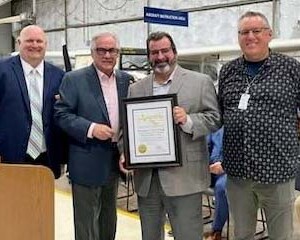Aircraft Mechanic finds the ideal job after finishing the right education and training

Stephanie Garcia made a smooth transition from 5-1/2 years active Air Force military service to her current status in the U.S. Air Force reserves for another 2-1/2 years. Her one weekend a month, plus two weeks a year commitment to the Reserves allowed her to do something she determined she needed to fulfill her career vision.
“I got Air Force experience working on aircraft, but it was mostly electrical,” says Stephanie, who had enlisted when she was 25-years old. “I wanted to go to class for hands-on training to get my A&P (Airframe and Powerplant) license.”
Stephanie had years of experience in the military as an aircraft mechanic where she worked primarily on F-15 fighter jets. “You work on it, then watch it take off on the runway and there’s a sense of satisfaction and pride,” she says.
She wanted to take her skill set and knowledge higher. “I had to get my A&P – that was the drive,” says Stephanie. “I had no experience in Powerplant and didn’t know anything about servicing engines, learning the operations of a jet engine or how it works to create thrust.”
There are other benefits to having an A&P license. “You make a little more money, and I would be able to create a lifestyle I wanted for myself and my fiancé (Kayla). And, I wanted to do something I really enjoy doing. As they say, ‘if you do something you enjoy, you’ll never work a day in your life’.”
Stephanie found everything she needed in SJVC’s Associate degree-granting Aviation Maintenance Technology (AMT) program on the TEC campus located at the Fresno Yosemite International Airport. The AMT program enjoys a site where their hangar’s proximity to the large commercial and private-use airport allows them to hear and watch aircraft of all sizes land and take off each day.
“F-15s have a special sound you can hear from the classrooms,” says Stephanie. “If one flies over, you have to stop talking because the afterburners are so loud. It’s music to my ears because it brings back great memories. That’s the sound of freedom.”
The classroom experience combined with hands-on training proved a perfect fit for Stephanie. “I’d worked on aircraft for 7-years, but I didn’t have the knowledge of everything else, like weight and balance. It’s a term for a plane to be stable – not too much weight in the nose or tail.”
Hands-on experience in the hangar held some favorite moments for Stephanie. “Working with sheet metal, bending, shaping it to make a small section of a wing; that was my favorite part,” she says. “Looking at this sheet of aluminum and step-by-step you make all these different pieces from different drawings. You put it all together, and it’s a wing! It made me appreciate all of the smaller things on an aircraft.”
AMT classmates often work in teams on various diagnostic or repair challenges. “I came in with a great set of guys,” says Stephanie, who was one of two females in the class of about a dozen students. “Regardless of age, gender, orientation – we were there to do a job. And it’s important that we all do our jobs because lives are on the line (securing safety measures).”
Successful AMTs have several attributes: Solid knowledge and skill, good teamwork, and strong mental and physical abilities. “It’s a really physically demanding job, for sure,” says Stephanie. “It helps to be in physical shape; you have to be mindful of how to lift things, using knee pads. It’s the wear and tear of the job, and you have to have safety in mind, always.”
Aviation Maintenance Technology program faculty were there to provide as much support as students needed. “If I wasn’t catching on to something, I could go to the instructor and they would sit down with me and explain it,” says Stephanie. “A lot of people are shy about asking questions (in class), but I would highly encourage you to ask questions. You might ask a question that somebody else didn’t but was wondering the same thing.”
Stephanie earned a 4.0 GPA and was one of the students who was asked to occasionally help others who might be struggling with the coursework. “A few of us were asked a couple of times to tutor other students who were struggling on academics. It’s important to set your partners up for success.”
Most of the time that support boost was all that was needed. But, occasionally, someone got close to giving up. “It’s important to have people there for you to inspire you, especially if you’re close to finishing the program,” says Stephanie. “An instructor would remind us to remember why we’re here – what’s your drive, what’s your reason, what motivated you in the first place. I tell them ‘you’re going to get through it, and it will be worth it in the end’.”
Stephanie had her own struggles. “School was four days a week, eight hours a day, so I had 3-day weekends. But when I had to go for reserves (one weekend a month), I’d drive up Friday (4 hours), work Saturday-Sunday and drive back for Monday class. Thankfully, I had GI benefits and I’m very grateful for that because a lot of guys have to work (full or part-time job) and have a family to support (while in the AMT program).”
Stephanie successfully completed the AMT program in June and recently started her position as an aircraft mechanic for IAP Worldwide Services, a company that contracts with the military. “I like that they support the military, so that I can continue to be a part of serving the military,” says Stephanie.
As part of an aircraft maintenance field team, Stephanie will travel to distant parts of the west coast, as well as Alaska and Hawaii. “My new job requires 100% travel most of the year,” says Stephanie.
She is not worried about job security. “I’m pretty confident. As long as airplanes are still flying, they’re going to need ongoing maintenance.”
Like the sheet metal Stephanie loves to work with, she will bend with the needs of her new career.
You might also like
More stories about
Request Information
All fields using an asterik (*) are required.


